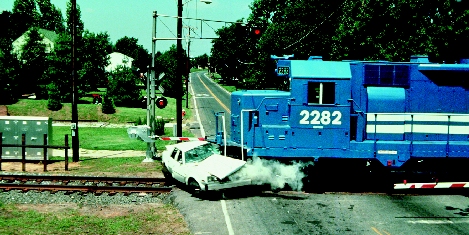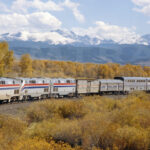A Tragic but Avoidable Waste.
Question: What happens eight or nine times a day, kills more than 250 people a year, and injures almost 850 more?
.
Answer: trains hitting cars or trucks at railroad crossings. The injuries and deaths are bad enough, but the real tragedy is that every one of those incidents could have been avoided.

.
Spearheaded by the Union Pacific Railroad fifty years ago and with the other railroads quickly joining the effort, Operation Lifesaver was created to promote awareness of the problem of grade crossing deaths and injuries. Their efforts showed results almost immediately.
.
In 1980, there were 9,500 grade crossing accidents resulting in 728 fatalities. By the year 2000, the number of accidents had been reduced to about 3500 and the number of fatalities to 425. By 2018, the number of accidents had fallen again—down to 2,217—and there was a corresponding drop in the number of people killed . . . to “only” 262.
.
The fact is, however, a year with no grade crossing fatalities is almost certainly unattainable. Drivers are human, they make errors of judgement, and incidents at grade crossings, fatal and otherwise, will no doubt keep occurring.
.
And that’s really too bad because, in addition to the injuries and deaths suffered by people in the vehicles hit by trains at grade crossings, there are other victims of these incidents who are quite blameless: the men and women operating the locomotives. Sadly, many of them pay a heavy price for another person’s recklessness.
.
Immediately following one of these tragedies, counseling is provided for the train’s operating crew. Most engineers, knowing they had blown the whistle and braked as much as possible, keep things in perspective and deal with the tragedy successfully. Some, however, have trouble coping and a few, regrettably, are so affected they are unable to get back into a locomotive cab.
.
Realistically, it’s not possible to eliminate grade crossing incidents entirely, but a tip of the cap to those who volunteer their time to Operation Lifesaver and continue to take their message to schools and communities all over the country.



We would love to go thru Utah, California, etc. We live in Rapid City SD and would more than likely be going to CO to climb on an Amtrak. Is there any way or site to easily accomplish this trip and taking a couple of your “power visits” in towns or attractions along the route? Thank you all so much for all of these little info-stories. I have taken an Amtrak from MPLSSTPL to CHI. I was 19, in extreme party mode… and really dont remember a damn thing except the upper part of the train, and a cab driver that told us, ” You girls be smart to look no one in the eye but the sidewalk cracks.”
Im sure we had a good time. Because like I said.. I dont renember a thing. 😁
Thank you for your time!
May I ask what “at grade” means in regards to an accident?
Totally agreed, even if I would say virtually all are avoidable. Unfortunately, last year, we experienced an at grade accident where a train hit a car, that was not the car driver’s fault, but a combination of some silly rules, and a single case not crossed on the form given to a train driver who was evacuating a broken-down train in the opposite direction. The barriers weren’t down, and the bells only started ringing 2 or so seconds before the train arrived. Unfortunately, that’s the moment a car was still on the crossing…
These accidents are very rare, luckily.
As an Operation Lifesaver volunteer, the tip of the cap is much
appreciated.
As, indeed, are your efforts!
This issue is one of the main reason Amtrak trains are late.